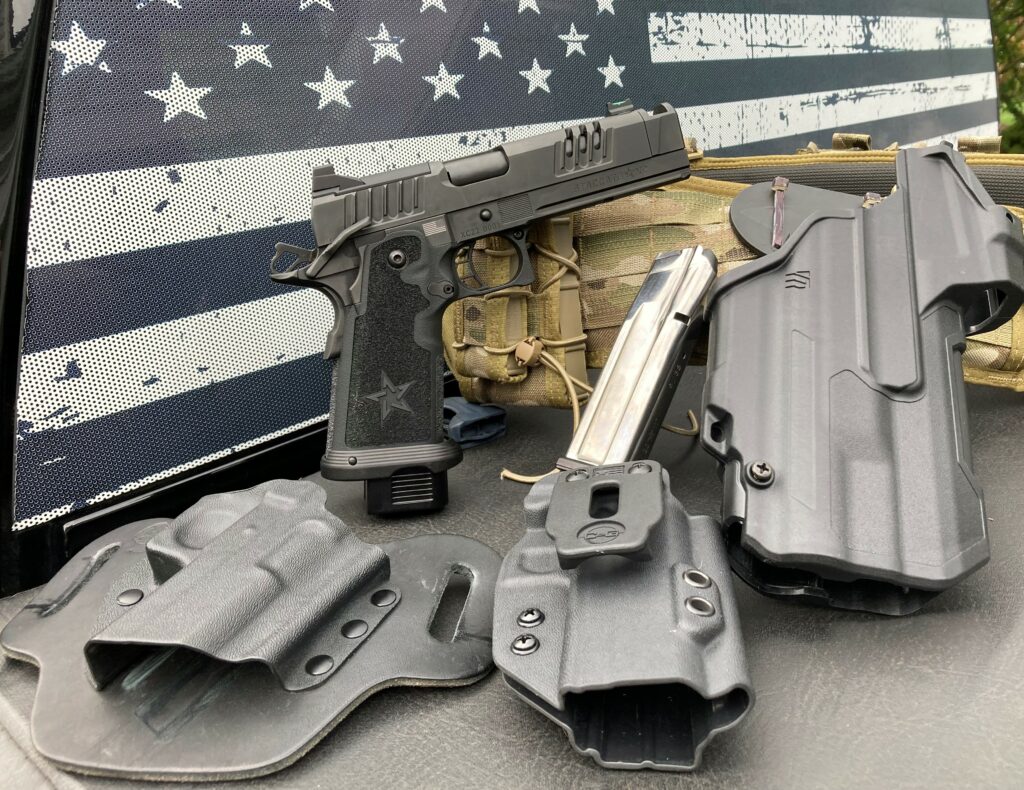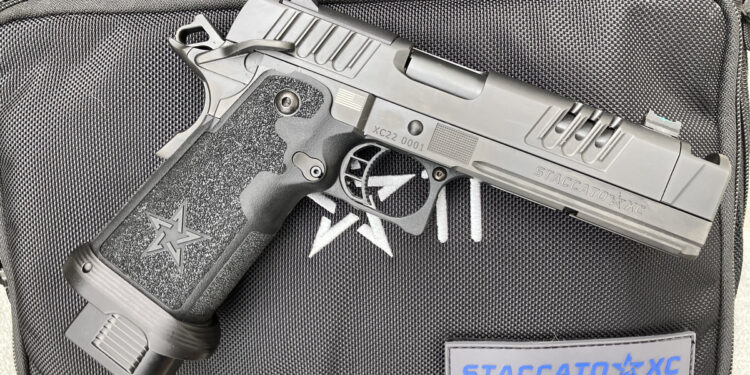By Todd Burgreen –
Of late, much attention seems to be focused on “improving” handgun platforms using compensators, suppressors, red dot optics, lasers, and lights. This is not only for running more efficiently, but also to add increased flexibility when responding to threats. Staccato is here to help with their Staccato XC. The Staccato XC platform itself is the enhancement. Don’t worry, the XC also accommodates the accessories mentioned and has an integrated compensator seamlessly fitted up front. The XC is Staccato’s labor of love, exhibiting an extra degree of hand fitting and tweaks and making it the premier rendition of what the high-capacity 9mm 2011 platform offers.
From STI to Staccato
From its beginnings in the 1980s as a supplier of high-end 1911 components, then transitioning into offering high end 1911/2011 pistols under the STI moniker, one thing is certain—Staccato has been at the forefront of modernizing the 1911 in ways not previously conceived. The area of competition shooting led their initial market drive. Staccato later decided to focus on the tactical arena based, on experience garnered with its STI Tactical models. The adaptation into the tactical realm—and name change to Staccato in May 2020—was, and is, based on Staccato’s new leadership team which features people with strong military and law enforcement backgrounds. This was all foreshadowed in 2018 when the U.S. Marshal Service chose the 2011 STI Staccato 9mm for its elite SOG unit. Long Beach SWAT was another early convert to the Staccato 2011 9mm platform. High round count testing protocols with these agencies gave invaluable feedback to Staccato in terms of production methods, material upgrades for certain high wear parts, its recoil system, and, most importantly, improvement to its magazine design.
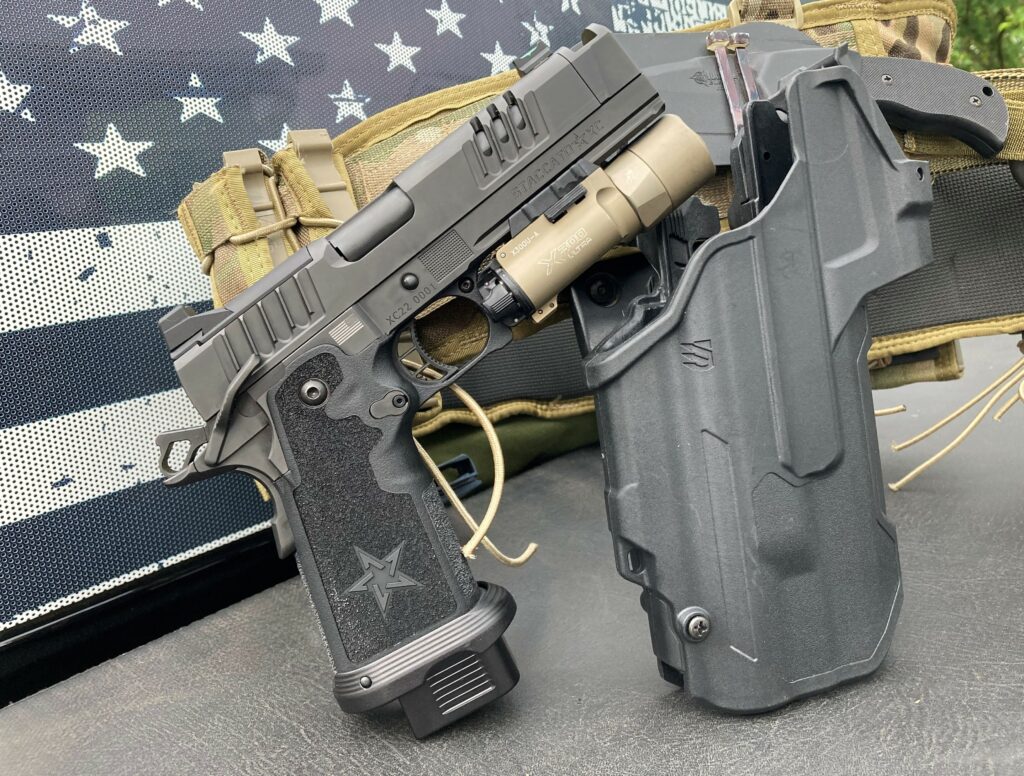
The 2011

In AR terms, think of the 2011 frame as the “lower” and the slide as the “upper.” The patented 2011 frame arrived in 1994 as an invention of STI. It’s is a modular, two-piece design consisting of a 4140 steel forend section mated to a polymer grip section. The steel component contains the rails that interact with the slide, fire control group, thumb and grip safeties, slide stop, and railed dust cover. The grip is made of a proprietary glass-filled polymer with side panels featuring a raised pattern design for texture. The same raised pattern from the grip is found on the front strap and flat mainspring housing. The Staccato XC’s slide is CNC-machined, heat-treated 4140 steel. The stainless-steel slide features angled front and rear slide serrations. All metal components have DLC finish.

The 2011 polymer grip is contoured to maintain 1911 characteristics while accommodating a high-capacity double-stack magazine. Staccato sagely decided to keep the 17-degree grip angle that the 1911 is renowned for. A nuance of the polymer grip construction is its relatively thin front strap and sidewalls, which allows for measurements comparable to a typical single-stack 1911 but with twice the round capacity. The 2011 frame does not require a gargantuan paw for the shooter to feel in control of the gun. There is only a 0.25-inch difference in circumference in a 2011 frame compared to a 1911.

Staccato’s design philosophy is to combine the highest quality raw materials, the best CNC equipment, and the most thought out components. The most important part of the manufacturing process is the master gunsmiths pulling it all together. There are no assembly line methods with the Staccato XC. It’s a limited production item.
The Details
The Staccato XC’s single action trigger pull is factory set for a 2.5 pounds. Performance enhancing features include oversized ambidextrous thumb safeties, a high-grip beavertail safety with a palm pad, and an extended ejector. The Staccato XC weighs 37.5 ounces with its 5-inch bull barrel.

The XC’s barrel/slide configuration is an indicator that something special is afoot. The “island” front sight affixed to the barrel nestled behind the single-port compensator quickly grabs your attention. Typical of Staccato, the compensator is not merely screwed onto a threaded barrel. In fact, a design was created that does not require a threaded barrel. This is good news for those living in jurisdictions prohibiting threaded barrels. The compensator and island front sight are part of the barrel that’s independent of the slide. This maintains maximum sight radius and allows for superior front sight tracking between shots.

The Staccato XC’s second generation double-stack magazine is a redesign of the original STI magazine with its body set to precise and consistent measurements at the feed lips and follower and throughout the length of the magazine body—both front-to-back and side-to-side. This translates into more consistent reliability and performance. In addition, features such as witness holes and polishing of the interior and exterior of the mag body further enhance the quality of these magazines. The “ribs” of the 9mm magazines run all the way down both sides. The days of needing to “tune” STI competition weapons and magazines are over. Staccato 2011s are meant to function reliably right out of the box. The 2011 9mm platform uses 16-, 17-, 20-, or 26-round magazines with the Staccato XC arriving with two 17-round and one 20-round magazine.
It Feels Good
My prior experience with STI Tactical 45 and Staccato C2 2011s left me impressed. How could the Staccato XC improve? All the descriptions, no matter one’s best effort, fall short in conveying how smooth the XC operates. The pistol harkens back to the STI competition days with its performance level. However, the XC is all about real world applications—whether it’s on the range for training, sporting, and, most importantly, duty or personal defense roles. Staccato’s commitment to reliability for the tactical realm stays in place with the XC.
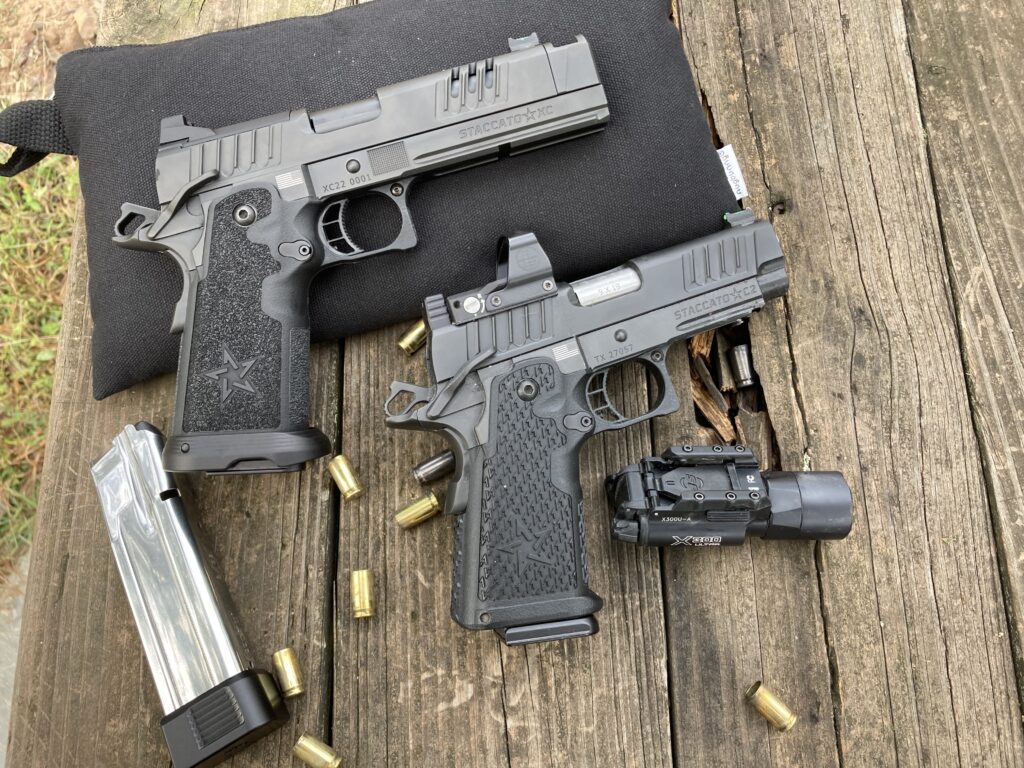
It’s not just the integrated compensator that defines the shooting experience. While the single-port compensator is certainly icing on the cake, Staccato doesn’t rely on it to define the XC experience. The XC is not just another Staccato model with a comp screwed on to create a different model SKU. Staccato has hand fitted, tuned and timed the XC’s slide using a tool-less guide rod spring assembly for efficiency.
Effective shooting is not just dealing with recoil and blast. The slide returning to battery is also a factor impacting sight alignment and grip. This is why professional shooters take the time to analyze different recoil spring weights during shooting sessions. You want enough spring poundage to cycle the slide reliably, but not so much that it causes the slide to slam forward violently after ejecting empty brass.

The Staccato XC’s slide seems to operate on ball bearings, moving so fluidly that the island front sight tracks smoothly during recoil. The XC’s setup allows the bulk of kinetic energy to be expended in the process of loading a new round from the magazine with the slide coming forward more gently and with a fraction of the force found in a typical recoil spring set up. This reduces the slide slamming forward and reduces muzzle dip. It also provides less felt recoil, helping you keep follow up shots on target or stay on track with moving onto the next one. Now after taking all this into account, add a compensator. Most literature on compensators indicate a 30% to 40% reduction of muzzle flip. Muzzle flip reduces the speed with which you can accurately fire multiple rounds. A well-designed compensator allows for an easier job in firing the weapon under normal conditions as well as under duress or with one hand. When in a personal defense situation, there’s no responsibility to engage in a fair fight. That’s why premium weapons, such as the Staccato XC, attract tactical shooters with its superior ergonomics and performance.
Drilling Down
I used diagnostic instructional scenarios in the form of the Bill Drill, El Presidente, and IDPA 5×5 qualifier drills to explore what the Staccato XC offered. Each of these drills place a premium on recoil control, trigger manipulation, and sight tracking. Blackhawk, Crossbreed, and C&G holsters were used with the Staccato XC. Ammunition spanned the gamut from Ammo Inc. 115-grain TMC, SIG Sauer 124-grain JHP, and Norma’s 115-grain FMJ, exotic 65-grain NXD, and 108-grain MHP loads.
With the Bill Drill, you start with handgun in the holster with hands in surrender position at shoulder level. A target is placed seven yards downrange. On command, draw and fire six rounds as rapidly as solid hits allow. Following your sights during recoil is crucial. When done properly, the front sight is never stationary—you just ride the recoil long enough to confirm the front post is back in the “A” zone and send another round into the target. The Staccato XC allowed me to generate times in the 2.4- to 2.8-second range.

The El Presidente (“El Prez”) is a three-target array spaced three feet apart and placed 10-yards downrange. You start with your back to the targets, hands in surrender position, firearm in the holster with six rounds in the gun and six rounds in a spare magazine. Upon command turn, draw and fire two rounds into each target starting from the side of your choice, reload and engage targets with two more rounds opposite your first run. The El Prez works draw stroke, movement, sight alignment, reload, and transitioning between targets. The Staccato XC allowed me times of 10.5 to 11.5 seconds while achieving proper hits.
The IDPA 5×5 classifier is another good indicator of how well you and handgun meld together—especially if you track performance with different handgun styles. Target is 10 yards away. Four strings of fire are used to generate total time with penalties for anything out of the “A” zone.
- String 1 Draw and fire five rounds freestyle.
- String 2 Draw and fire five rounds strong hand only.
- String 3 Load five rounds into a magazine, draw and fire, emergency reload, fire five more rounds.
- String 4 Draw and fire four rounds into the body and one round to the head of a target, freestyle.
The Staccato XC helped me generate times in the 22-24 second range for this IDPA qualifier drill.

I felt I was letting the XC down at times during all the drills. While my drill times were some of my best (of late) I could tell the Staccato XC wanted to go faster, but my abilities were not up to it. This is a credit to the weapon. The Staccato XC’s island fiber optic front sight, combined with its muzzle-flip- minimizing compensator, allowed for superior sight tracking between shots. The Staccato XC’s excellent single-action trigger pull provided another important advantage. The XC’s magazine well acted like a funnel during magazine changes. There were no reliability issues during the high volume, fast paced drills.
Performance
| LOAD | Velocity Avg. | Accuracy @25yds |
| SIG Sauer 124gr JHP | 1160fps | 0.85in |
| Norma 108gr MHP | 1272fps | 1.2in |
| Norma 65 gr NXD | 1612fps | 1in |
| Ammo Inc. 115gr TMC | 1094fps | 1.5in |
Range Observations
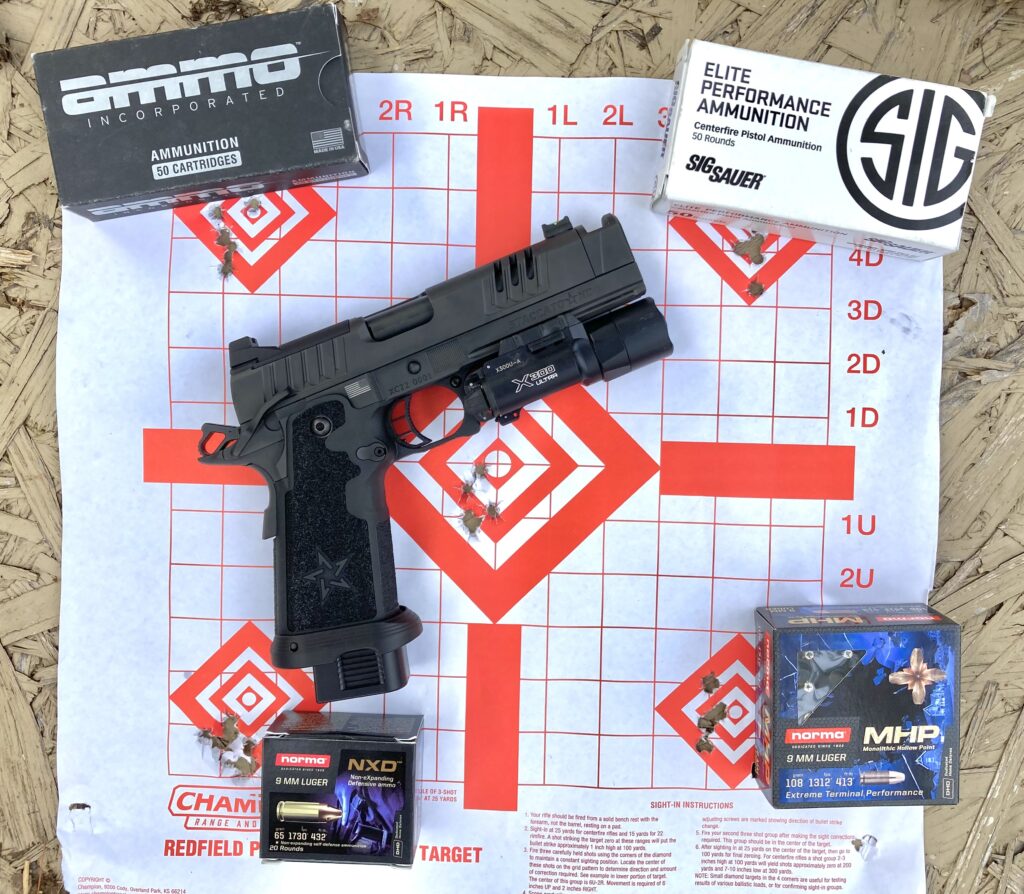
Mind your hand placement when manually racking the slide. Don’t grab the slide too far forward, near the comp. If you do, two things can happen: you might pinch your hand between the slide and comp, or you’ll end up fruitlessly trying to rack the gun while pinching the stationary compensator instead of the movable slide. The brass ejection is eerily consistent on the Staccato XC, with spent casings landing a few feet away nearly 90 degrees from slide. This illustrates the uniformity of the pistol maker’s machining, the time spent hand-fitting the slide to the frame, and the value of properly adjusting the pistol’s extractor and ejector.
Ammunition Notes
There were no issues with any of the ammunition we used in our test, with one caveat related to the Norma NXD and MHP premium defensive loads. Each cycled the slide, and were very accurate, however, neither would lock the Staccato XC’s slide to the rear after the last round was fired.
Sight Options

Lastly, testing for this evaluation did not involve mounting a red dot optic on the XC. The XC does arrive with the innovative Dawson Precision Optic reflex sight system in place for those who want to mount a red dot. Multiple plates allow for red dots (with Trijicon RMR and Leupold Delta Point Pro footprints) to attach to the XC while providing a co-witness with iron sights. The XC’s steel frame dust cover with rail offers a solid connection point for lights and lasers. A Surefire X300 was mounted at different times for this evaluation with no detriment to reliability.
Wrap Up
Cost is inevitably brought up when discussing a handgun with a price tag over $4000. With the Staccato XC, you feel as if you have reached the pinnacle of craftsmanship, design, reliability, and efficiency that can be found in the 1911 and 2011 genres.
While the gun is certainly a viable consideration for competition, a more applicable role is using it as a duty or personal defense weapon. While you cannot purchase proficiency, the Staccato XC certainly feels like it offers a a skill enhancement. You perform better with the XC in your hand. There is no better compliment than this. A weapon like the Staccato XC feels analogous to a medieval knight’s broadsword or a samurai’s katana; it’s as much a talisman that signifies a warrior’s martial commitment as it is a weapon worthy of a legacy.
SPECIFICATIONS:
Make: Staccato
Model: XC
Caliber: 9mm
Barrel: 5in bull barrel with island front sight and compensator
Overall Length: 8.4in
Weight: 37.5oz
Sights: Dawson Precision Fiber Optic Front, Tactical Dawson Precision Rear sight. Equipped with Dawson Optic System for mounting red dot optics.
Capacity: Includes two 17rd and one 20rd magazines
MSRP: $4299
URL: Staccato2011.com
